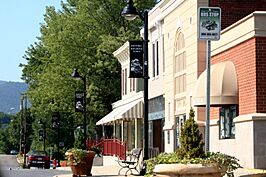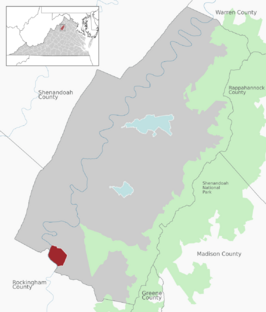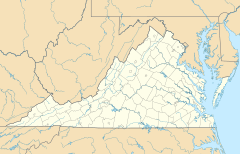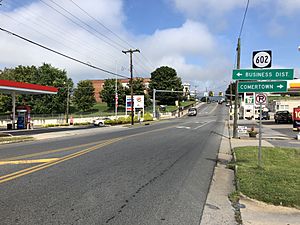Shenandoah, Virginia facts for kids
Quick facts for kids
Shenandoah, Virginia
|
|
|---|---|

Downtown Shenandoah
|
|

Location of Shenandoah within the Page county
|
|
| Country | United States |
| State | Virginia |
| County | Page |
| Area | |
| • Total | 2.26 sq mi (5.86 km2) |
| • Land | 2.17 sq mi (5.61 km2) |
| • Water | 0.10 sq mi (0.25 km2) |
| Elevation | 988 ft (301 m) |
| Population
(2020)
|
|
| • Total | 2,486 |
| • Density | 1,147.7/sq mi (443.1/km2) |
| Time zone | UTC-5 (Eastern (EST)) |
| • Summer (DST) | UTC-4 (EDT) |
| ZIP code |
22849
|
| Area code(s) | 540 |
| FIPS code | 51-71776 |
| GNIS feature ID | 1494269 |
Shenandoah is a town in Page County, Virginia, United States. In 2020, about 2,486 people lived there. It's known for its beautiful natural surroundings, nestled between the Blue Ridge Mountains and the Massanutten Ridge.
Contents
Exploring Shenandoah's Location
Shenandoah is located at 38.488225 degrees north and −78.621217 degrees west. The town covers about 2.3 square miles (5.9 square kilometers). Most of this area is land, with a small part being water.
Shenandoah is surrounded by nature. It sits between the beautiful Blue Ridge Mountains and the Massanutten Ridge. It is also about 8 miles (13 km) west of Shenandoah National Park. The city of Harrisonburg is about 25 miles (40 km) northeast of Shenandoah.
Shenandoah's Population Over Time
The town of Shenandoah has seen its population change over many years. In 2000, there were 1,878 people living in the town. By 2020, the population had grown to 2,486 people.
Here's how the population has changed over the years:
| Historical population | |||
|---|---|---|---|
| Census | Pop. | %± | |
| 1880 | 197 | — | |
| 1890 | 751 | 281.2% | |
| 1900 | 1,220 | 62.5% | |
| 1910 | 1,431 | 17.3% | |
| 1920 | 1,895 | 32.4% | |
| 1930 | 1,980 | 4.5% | |
| 1940 | 1,829 | −7.6% | |
| 1950 | 1,903 | 4.0% | |
| 1960 | 1,839 | −3.4% | |
| 1970 | 1,714 | −6.8% | |
| 1980 | 1,861 | 8.6% | |
| 1990 | 2,213 | 18.9% | |
| 2000 | 1,878 | −15.1% | |
| 2010 | 2,373 | 26.4% | |
| 2020 | 2,486 | 4.8% | |
| U.S. Decennial Census | |||
A Look Back: Shenandoah's History
How Shenandoah Began
Shenandoah was started in 1837 by two brothers, Daniel and Henry Forrer. They chose this spot because it had many natural resources. These included iron ore, hardwood trees, high-quality limestone, and waterpower. Being close to the South Fork of the Shenandoah River was also very helpful. The Forrers used the river to transport iron and other goods.
In 1838, the Forrers opened the first post office in Shenandoah. They called it "Shenandoah Iron Works." The town then began to grow with houses, businesses, and industries. The Shenandoah Iron Works, run by the Forrer brothers, was also built along the river. Many historical buildings were constructed, like Stephens Cottage and the South Fork House.
Shenandoah During the Civil War
The town of Shenandoah played an important part in the American Civil War. Three iron furnaces in the area turned raw iron into "pig iron." This was a basic form of iron used to make other things. Before the war, pig iron was shipped on boats down the Shenandoah River. During the war, it was sent by wagon and then by train to Richmond. There, it was used at the Tredegar Iron Works to make weapons.
Cannonballs were also made at some local furnaces. Gunpowder from a nearby plant was also shipped out. All these supplies were used by the Confederacy during the war.
Rebuilding and the Railroad Era
After the Civil War, in 1866, two men named William Milnes, Jr. and Thomas Johns bought a large area of land in Shenandoah. This included the Forrer's Shenandoah Iron Works. They continued the iron business but used new, modern machines to make production better.
Shenandoah is located very close to the Shenandoah River, which means it has often experienced floods. In 1870, a huge flood hit the town. Between 30 and 60 buildings were completely destroyed or washed away.
Despite the flood, William Milnes helped the town rebuild. At that time, the country was experiencing an industrial boom. Milnes led the effort to build the Shenandoah Valley Railroad. This railroad would connect Roanoke, Virginia, to Hagerstown, Maryland. Thanks to Milnes, the railroad and a telegraph line were built. This made Shenandoah an important railroad town.
The railroad helped Shenandoah become a key point between Roanoke and Harrisburg, Pennsylvania. This allowed businesses to ship their goods by train instead of just by river. Milnes also built the "Big Gem Cast Iron Furnace" in 1882. It produced 110 tons of iron every day. The Big Gem was also a popular tourist spot because of the bright sparks it made at night. It literally lit up the whole town!
In 1882, the town's post office name was changed to "Milnes" to honor William Milnes. The town officially became a town in 1884 and was also named Milnes.
The railroad tracks were built next to the river and Front Street, which is now called First Street. This area became the main business center of the town. Many businesses were built facing the rail yard. Front Street became a busy "Main Street" where people would shop and watch the trains. However, in 1957, the Norfolk and Western Railroad closed its main facilities there. Since then, only a few businesses remain.
In 1890, the town's name was changed again, from Milnes to Shenandoah City. Later, the "City" part was dropped, and it became just Shenandoah. The year 1890 was also a time of fast growth for Shenandoah. The Shenandoah Land and Improvement Company bought land, planned streets, and built many new buildings. However, many of these buildings were later destroyed by fires, which have been a common part of the town's history.
Shenandoah in the 20th Century
Between 1890 and 1907, the country faced an economic downturn, and Shenandoah was affected. Businesses closed, and some went bankrupt. A fancy town hotel called "The Shenandoah" was destroyed by fire in 1891. Floods in 1896 washed away the river bridge, and another fire destroyed the town bank.
In 1907, the Big Gem Furnace stopped working. It was taken apart in 1917. The land where it stood was later given to the town in 1995 by the Lukens Steel Company. This 68.6-acre (27.8-hectare) area became an outdoor park called "Big Gem Park."
Since the railroad facilities on First Street were reduced in 1957, the downtown area has been quiet. Most of the town's growth has happened along Route 340. Shenandoah, like many small towns, has faced challenges from large shopping centers. The town is now working on plans to bring life back to "Old Front Street" and use its rich railroad history to attract visitors.
Shenandoah in the 21st Century
Shenandoah's downtown faced more challenges from fires in the 21st century. On May 23, 2006, a fire destroyed two stores and a home. It took seven fire companies over 18 hours to put out the blaze.
Another big fire hit the downtown area on March 27, 2007. Again, seven fire companies fought the fire for nearly ten hours. Three buildings were destroyed, and four others were damaged.
The Commonwealth of Virginia has given the town grants to help make its Main Street (First Street) area beautiful again. In 2021, Page County received a large state grant to bring wireless internet to every home in the county. Before this, Shenandoah was the only town in Page County with wireless internet.
Several historic buildings and areas in Shenandoah are listed on the National Register of Historic Places. These include the Shenandoah Historic District, the Shenandoah Land and Improvement Company Office, the Strickley-Louderback House, and the Welfley-Shuler House.
As of 2017, Norfolk Southern owns a large railyard across from First Street. Many trains can be seen there daily. At the north end of the yard, you can still see parts of the old Norfolk and Western shops. These shops were closed when trains started using diesel engines instead of steam.
Getting Around Shenandoah
The main road that goes through Shenandoah is US 340. There are also other local roads that help people travel to nearby rural areas.
Famous People from Shenandoah
- Ed Austin (1926–2011) was the mayor of Jacksonville, Florida.
- Wayne Comer (1944–2023) was a Major League Baseball player.
- William Milnes Jr. (1827–1889) was a congressman and businessman from Virginia and Pennsylvania.
- Kenneth R. Plum (born 1941) is a Democrat who serves in the Virginia House of Delegates.
See also
 In Spanish: Shenandoah (Virginia) para niños
In Spanish: Shenandoah (Virginia) para niños




